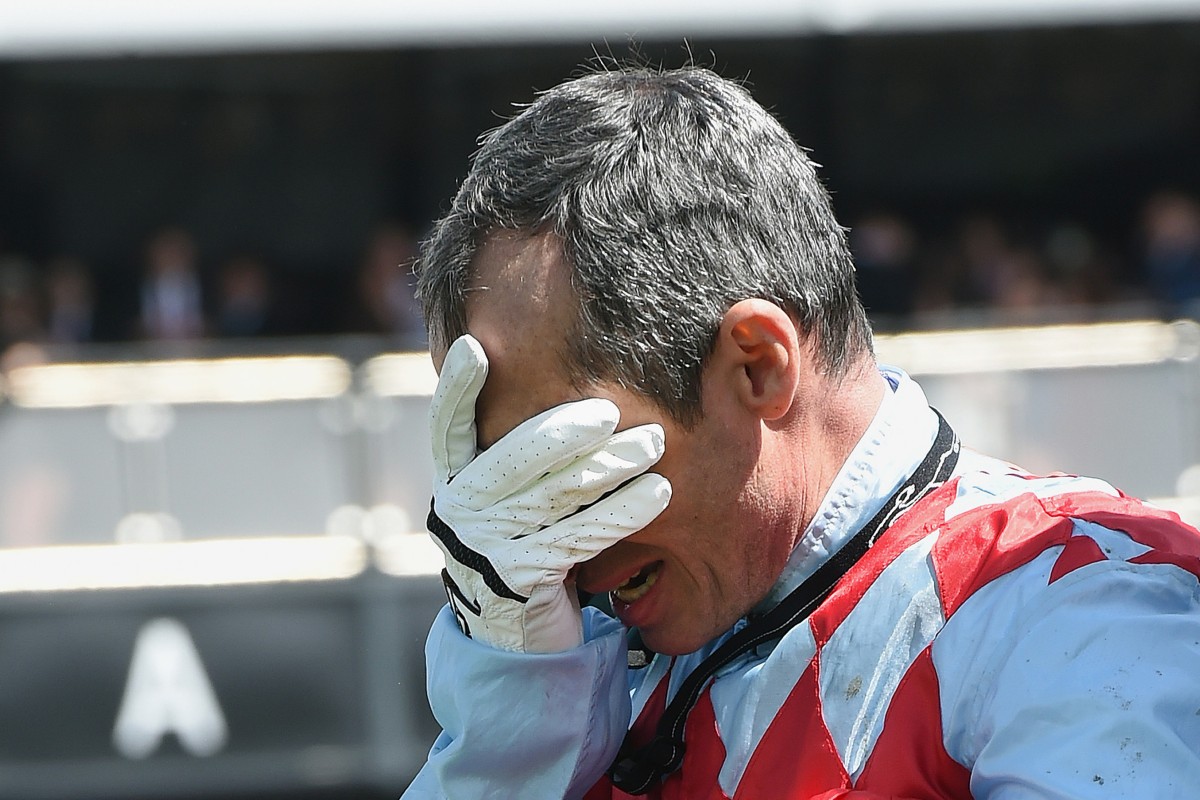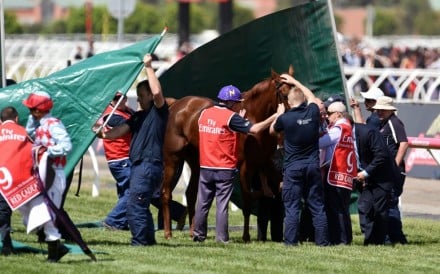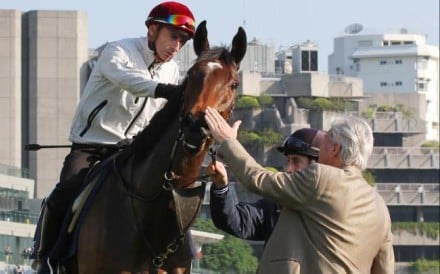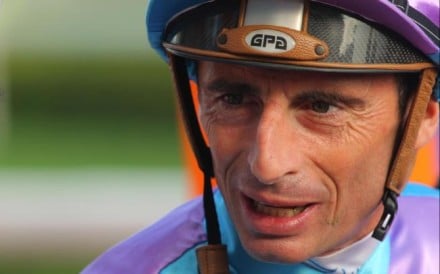If a picture paints a thousand words, as the old adage goes, the floods of images emerging from Australia’s greatest race on Tuesday have compiled a masterpiece of literature.
For most, the defining image of the Melbourne Cup will be Michelle Payne, the first female to ride the race’s winner, and brother Stevie, who has Down syndrome but excelled as the strapper of rank outsider Prince Of Penzance, celebrating their unlikely success. It is a feel-good story on so many levels.
However, while the pictures of the Payne siblings have been splashed all over the world, from Toronto to Tel Aviv to Timbuktu, the most poignant photograph to emerge from the race is far darker and more confronting, well removed from the celebrations in the winner’s enclosure.
Jockey Gerald Mosse, visibly distressed as he walks away from injured fan favourite Red Cadeaux, will go down as one of the most powerful images captured on a racetrack.
Michelle Payne may have told her detractors to “get stuffed”, but Mosse’s emotional display should be seen as a similar slap in the face to the anti-racing lobby – those who insist that everyone associated with horse racing is cruel, selfish and uncaring, putting wealth and fortune ahead of horse welfare.
 Melbourne Cup day brings national attention to a sport that quite often languishes on the periphery of Australian culture.
Melbourne Cup day brings national attention to a sport that quite often languishes on the periphery of Australian culture.
Year-round, the races are a social event, a chance to drink, to gamble, to enjoy the vices of life. The horse is merely a sideshow, and the equine vagaries are understood by a minority.
That is, except for Melbourne Cup day, when one and all become experts and 30 seconds of looking at a form guide affords Joe Bloggs the same platform as someone who works in the game 365 days a year.
Lack of understanding about the ins and outs of horse racing ensures there is a wealth of misinformation about racing, with a number of bodies, like the Coalition for the Protection of Racehorses, peddling inaccurate figures in a bid to attract sensationalist headlines.
In their warped world, every person associated with racing – the man on the street having a small bet, the apprentice jockey, the big name trainer, the young journalist – is heartless and advocating animal cruelty.
Are there cruel, selfish and uncaring people in racing? Of course, but similar people are found in nearly every industry anywhere.
If anything, the majority of racing people – particularly jockeys, trainers and stable staff – are unassuming types who have an inexplicable bond with the horses with which they associate on a daily basis.

Mosse is a perfect example. He is the consummate horseman, a man who is at heart a lover of horses.
This is something the anti-racing lobby refuses to comprehend, though – how can a man who dominates horses for a living, who rides thoroughbreds just to attract wagers with little thought of a horse’s welfare, actually care for the 1,000-pound beast beneath him?
The whole irony of the anti-racing movement is the delight, almost euphoria, when a horse breaks down. It's a sick form of martyrdom - one dead horse helps to save 1,000 more, or so they believe. It justifies their cause and proves that racing is a cruel sport, apparently.
So you could almost detect the muffled cheers of the anti-racing crowd among the gasps of the 100,000-strong crowd as one of the horses slowed to a limp opposite Flemington's famous clock tower.
The horror would have been ubiquitous had any of the 24 runners broken down, but it was Red Cadeaux. Not Red Cadeaux!
The evergreen Hong Kong-owned globetrotter has built up a loyal following worldwide, but the English chestnut is particularly popular in Australia, where he had finished agonisingly close in the world's richest handicap three times without winning.

On the first Cup day sans Bart Cummings, the Cups king who won the great race 12 times, had a runner in 42 of the 50 Cups between 1965 and 2014 and became the traditional 50 cents each way lock for mum and dad punters, Red Cadeaux filled the void left by the trainer's death in August.
Mum and dad punters instead stuck solid with Red Cadeaux, a reassuring face of continuity as he lined up for his fifth start in a race where 22 of the 24 runners were contesting their first Melbourne Cup.
Even The Griffin's mother, faced with an impossible decision in a contest as wide open as any literal or figurative Melbourne Cup field before it, held faith with old Red, the only thoroughbred she could immediately identify by name.
When the green screens were erected 100 metres from the Flemington winning post, the worst was feared. His death was tweeted prematurely, and there were reports of racegoers in floods of tears at the horrific sight of a fallen warrior.
Mosse, who had pulled him up as soon as he felt an off stride, quickly dismounted and tried to stabilise him. Once the veterinarians arrived with trainer Ed Dunlop and travelling foreman Robin Trevor-Jones, Mosse – who had ridden Red Cadeaux 16 times over the last three years – walked away shaken, tearful and too upset to speak. The picture speaks to the heartache he felt at the apparent fate of a horse he clearly loved and with which he had a close bond.
CAN YOU BELIEVE IT! PRINCE OF PENZANCE takes out the 2015 #EmiratesMelbourneCup! Results: https://t.co/gwBBsc67M8 https://t.co/4w86XV3OQn
— Racing.com (@Racing) November 3, 2015
It couldn’t have come at a worse time. The Melbourne Cup was already under closer scrutiny by a mainstream media concerned by animal welfare issues after a horrific couple of years.
In 2013, the Aga Khan's Verema broke down as the field began their trek up the Maribyrnong River side. Last year, Caulfield Cup winner Admire Rakti - having finished a long last in the Melbourne Cup - collapsed and died in the tie-up stalls post-race, while seventh-placed Araldo was spooked by an Australian flag waved by a racegoer and suffered a freak injury.
Verema's injury, a shattered cannon bone in her near-foreleg, could have just as easily happened to a horse in any paddock, anywhere in the world. In the case of Araldo, especially, it was a freak accident.
Forget that there had only been two deaths in the race in the 40 years up to 2013. Suddenly, the Melbourne Cup was dangerous and anyone partaking in festivities was glorifying cruelty towards animals.
Protesters took the opportunity pre-race to remind the masses on the lawns and in the stands at Flemington, taking to the track and attempting to chain themselves to the fence near the winning post in an endeavour to stop the race.
A protester is removed by security after handcuffing herself to rail at Flemington just before the Melbourne Cup. pic.twitter.com/dOxrZgP12m
— Jay Town (@JayTown2) November 3, 2015
It was like a D-grade attempt at repeating Emily Davison’s protest at the 1913 Epsom Derby, where the suffragette ran in front of King George V’s horse Anmer and died.
If Red Cadeaux had been euthanised, not only would it have been a great tragedy, but the Melbourne Cup would have been in severe trouble. No matter the reality, the image would have been a nightmare.
Prince Of Penzance, Michelle Payne and trainer Darren Weir would have had their historic moment tarnished and the Melbourne Cup would have had a reputation from which it would have been extremely difficult to recover.
In this instance, the gulf between life and death was a matter of perception.
To the dismay of the protesters but to the cheers of the crowd, Red Cadeaux got to his feet, walked onto the horse ambulance and is now recovering from surgery.
The injury, a fractured sesamoid, is serious and the road to recovery is long, but the horse is set for a long, fruitful life at Living Legends in Melbourne, alongside some other champions of the past two decades.
If a picture paints a thousand words, then Mosse’s emotional display has spoken volumes for the love and care for racing participants towards their horses.
It’s a powerful message, a poignant reminder that whatever the perception, racing is a game built on respect, admiration and affection for the thoroughbred – something that should never be forgotten.



















